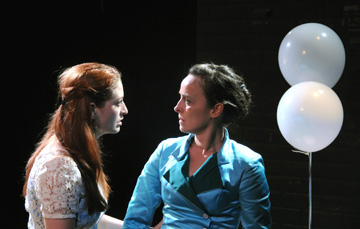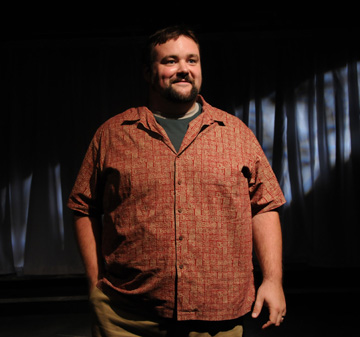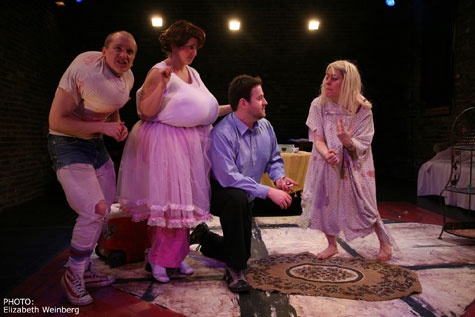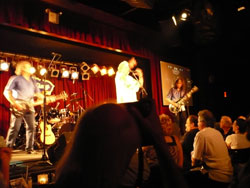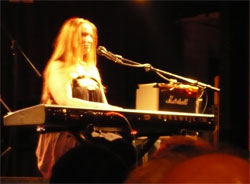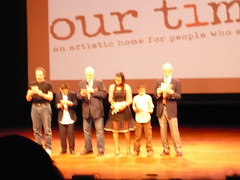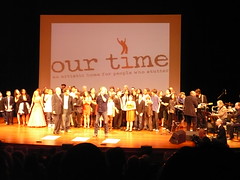Deni Bonet, Last Girl on Earth
Deni Bonet has always been more than the in-demand session violinist many know her as. Her new CD shows her, with her clutch of co-writers, in excellent songwriting form.
The arrangements meld 1980s plastic with new-century thump. Local luminaries like Sara Lee and Richard Barone keep everything solidly grounded, but it's the songs that make the disc a keeper: catchy and often humorous, but with a low-churning serious undercurrent tugging on many of the lyrics and musical passages. When Bonet sings "I can't, I can't, I can't get anything done / 'cause I'm having too much fun" in hollowed-out tones, there's a clear feeling of dismay tickling the shiny surface sentiment.
Bonet's strings and accordion take turns with ska-ish horn arrangements, micro-hoedowns, Martha and the Muffins vocal harmonies, and – as her stage directions specify – "moody obligatory violin areas." The result is a tingly jacuzzi of festive adult pop. "I don't need drugs, I don't need help / I'll fuck it up all by myself / Deepak Chopra kiss my ass / I've got advice for you / I say… Fuck it."
Ain't that just darling?
Joan Jeanrenaud, Strange Toys
Sticking with string players, but leaving behind the world of pop music for a moment, I have to mention the new disc from former Kronos Quartet cellist Joan Jeanrenaud. Its fourteen original Jeanrenaud compositions, all centered around her cello, feature plenty of looping and effects, and in some pieces, artfully situated guest musicians. They are compellingly listenable.
There are elements of minimalism, with the repetition that looping encourages. The inventive producer, pc muñoz, contributes beats too. But lyricism dominates many of the pieces, though never of an overly sweet sort, and the pieces are never less than fascinating or at least ear-tickling.
A centerpiece is the 13-minute "Transition," a quartet with a second cellist and two viola da gamba players. It begins with a deep, mournful solo cello line. Counterpoint arrives, then multiple harmonies, building a theme-and-variations movement reminiscent of early French court music a la Marin Marais. A second movement, percussive and moody, is punctuated by growling bow action and propelled by bouncy, disjointed mini-melodies that swell into modernistic, semi-minimalist moans. One half-expects a third movement, but it doesn't arrive; instead, the piece devolves to the original statement and simply dies out. Very effective.
Having grown out of improvisations, the compositions retain a sense of surprise and whimsy despite the composer's precise performances and perfect intonation. "Tug of War," with William Winant providing a kind of continuo on the marimba, is one of the best examples of this – it's like a little psychedelic jam. Winant's vibraphone intervals on "Livre" take me back to the Twilight Zone, and the brief "Blue Kite" is a gem of tight-fisted anxiety, while other pieces, like the lovely, densely woven "Waiting," are more soothing.
Actually, listening to this darn CD is keeping me from getting my work done. Damn you, Joan Jeanrenaud.
Citizens of Contrary Knowledge, You Are What You Wish You Are…
Here's why it's worth going through the hundreds of CDs that come through your intrepid reviewer's metaphorical transom. Sometimes you come across a band, like Citizens of Contrary Knowledge, that can do it all: play, sing, write, and on a more mysterious level, simply connect.
There are a lot of more or less retro influences here: Led Zeppelin, Foreigner, the Eagles, Stone Temple Pilots. But the grainy rock of tracks like "Complicated" and "Lonely Hearts Society" leap out of the speakers with a finely wrought web of sound and words that pays tribute to those influences while making their own musical statement.
The rocker "Spread Your Wings" is both elemental and lyrical, while "Brand New Dance" brings the Prince-like funk. The versatile Chris Barczynski can sing, emote, and scream like the greats. He can deliver ballads like "House of Cards" and "Beautiful Dreamer" as convincingly as he sings the rockers. The rest of the band shines equally brightly, from the ballads to the dynamic, Zeppelin-inspired "Swallow" and the blues-rocker "Wrong Side of the World."
True Heart, The Road
Speaking of the Eagles: True Heart's Ross Vick is able to sing decisively and plaintively at the same time. This magical combination breathes life into his well-crafted pop-rock songs. Though Vick is from Texas, the biggest influence here seems to be Eagles-era California smooth rock. There's definitely some Jackson Browne in his vocal tone.
Jazz-pop changes evoke Steely Dan and even Chicago, though you won't hear anyone blowing through anything here – it's all resolutely guitar and keyboard based (with dead-on bass and drums by James Driscoll and Matt Kellum respectively). Cliches overrun the lyrics, but the lilting pop melodies, sugary vocals, and expert musicality harmlessly absorb them.
Julian Sakata, See?
Another artist heavily influenced by music of the 1970s is Julian Sakata, but his heroes are the darker-tinged, artsier rockers like David Bowie and Elvis Costello (and, going back further, perhaps the Moody Blues). His best songs, like the three that open the disc, and the anthemic "Everything's Beautiful Once," are thick and muscular. Where he falls down, as in "Little Sun," is when his writing is too derivative of current pop hits, and Sakata's baritone vocals start to sound monotonous. Still, the best stuff here is well worth hearing.
